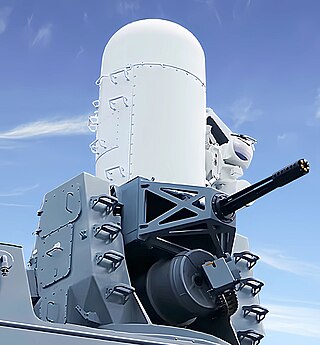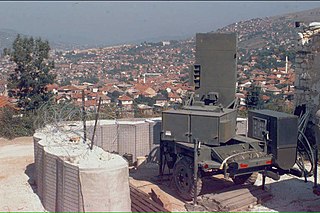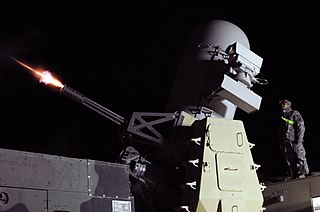
The Phalanx CIWS is an automated gun-based close-in weapon system to defend military watercraft automatically against incoming threats such as aircraft, missiles, and small boats. It was designed and manufactured by the General Dynamics Corporation, Pomona Division, later a part of Raytheon. Consisting of a radar-guided 20 mm (0.8 in) Vulcan cannon mounted on a swiveling base, the Phalanx has been used by the United States Navy and the naval forces of 15 other countries. The U.S. Navy deploys it on every class of surface combat ship, except the Zumwalt-class destroyer and San Antonio-class amphibious transport dock. Other users include the British Royal Navy, the Royal Australian Navy, the Royal New Zealand Navy, the Royal Canadian Navy, and the U.S. Coast Guard.

The Stryker is a family of eight-wheeled armored fighting vehicles derived from the Canadian LAV III, itself derived from the Swiss Mowag Piranha. Stryker vehicles are produced by General Dynamics Land Systems-Canada (GDLS-C) for the United States Army in a plant in London, Ontario. It has four-wheel drive (8×4) and can be switched to all-wheel drive (8×8).

The RIM-116 Rolling Airframe Missile (RAM) is a small, lightweight, infrared homing surface-to-air missile in use by the German, Japanese, Greek, Turkish, South Korean, Saudi Arabian, Egyptian, Mexican, UAE, and United States navies. It was originally intended and used primarily as a point-defense weapon against anti-ship missiles. As its name indicates, RAM rolls as it flies. The missile must roll during flight because the RF tracking system uses a two-antenna interferometer that can measure phase interference of the electromagnetic wave in one plane only. The rolling interferometer permits the antennas to look at all planes of incoming energy. In addition, because the missile rolls, only one pair of steering canards is required. As of 2005, it is the only U.S. Navy missile to operate in this manner.

The Avenger Air Defense System, designated AN/TWQ-1 under the Joint Electronics Type Designation System, is an American self-propelled surface-to-air missile system which provides mobile, short-range air defense protection for ground units against cruise missiles, unmanned aerial vehicles, low-flying fixed-wing aircraft, and helicopters.

A counter-battery radar or weapon tracking radar is a radar system that detects artillery projectiles fired by one or more guns, howitzers, mortars or rocket launchers and, from their trajectories, locates the position on the ground of the weapon that fired it. Such radars are a subclass of the wider class of target acquisition radars.

The AN/MPQ-64 Sentinel is an X-band electronically steered pulse-Doppler 3D radar system used to alert and cue Short Range Air Defense (SHORAD) weapons to the locations of hostile targets approaching their front line forces. It is currently produced by Raytheon Missiles & Defense.

The M982 Excalibur is a 155 mm extended-range guided artillery shell developed in a collaborative effort between the U.S. Army Research Laboratory (ARL) and the United States Army Armament Research, Development and Engineering Center (ARDEC). The Excalibur was developed and/or manufactured by prime contractor Raytheon Missiles & Defense, BAE Systems AB and other subs and primes in multiple capacities such as Camber Corporation and Huntington Ingalls Industries. It is a GPS and inertial-guided munition capable of being used in close support situations within 75–150 meters (250–490 ft) of friendly troops or in situations where targets might be prohibitively close to civilians to attack with conventional unguided artillery fire. In 2015, the United States planned to procure 7,474 rounds with a FY 2015 total program cost of US$1.9341 billion at an average cost of US$258,777 per unit. By 2016, unit costs were reduced to US$68,000 per round. Versions that add laser-guidance capability and are designed to be fired from naval guns began testing in 2015. By October 2018, over 1,400 rounds had been fired in combat.

Skyshield air-defence system is a modular, light weight, short range air defense (SHORAD) system developed by the Swiss corporation Oerlikon Contraves. The successor to the Skyguard defense system, Skyshield is intended to rapidly acquire and destroy threatening aircraft and missiles, as well as to fulfill a C-RAM role.

The Type 730 is a Chinese seven-barrelled 30 mm Gatling gun/rotary cannon CIWS. It has a PLA Navy designation H/PJ12. It is mounted in an enclosed automatic turret and directed by radar, and electro-optical tracking systems. The maximum rate of fire is 5800 rd/m, and the effective range is up to 3 km.

Hughes AN/TPQ-36 Firefinder weapon locating system is a mobile radar system developed in the mid-late 1970s by Hughes Aircraft Company and manufactured by Northrop Grumman and ThalesRaytheonSystems, achieving initial operational capability in May 1982. The system is a "weapon-locating radar", designed to detect and track incoming mortar, artillery and rocket fire to determine the point of origin for counter-battery fire. It is currently in service at battalion and higher levels in the United States Army, United States Marine Corps, Australian Army, Portuguese Army, Turkish Army, and the Armed Forces of Ukraine.

Hughes AN/TPQ-37 Firefinder Weapon Locating System is a mobile radar system developed in the late 1970s by Hughes Aircraft Company, achieving Initial Operational Capability in 1980 and full deployment in 1984. Currently manufactured by ThalesRaytheonSystems, the system is a long-range version of "weapon-locating radar", designed to detect and track incoming artillery and rocket fire to determine the point of origin for counter-battery fire. It is currently in service at brigade and higher levels in the United States Army and by other countries. The radar is trailer-mounted and towed by a 2+1⁄3-short-ton (2,100 kg) truck. A typical AN/TPQ-37 system consists of the Antenna-Transceiver Group, Command Shelter and 60 kW Generator.

The 2R2M is a vehicle-mounted, rifled 120 mm heavy mortar produced by Thales of France. It is derived from the MO-120-RT towed mortar. The 2R2M is in service with 5 nations.

ARTHUR is a counter-battery radar system originally developed jointly for and in close co-operation with the Norwegian and Swedish armed forces by Ericsson Microwave Systems in both Sweden and Norway. It is also used by the British Army, under the names mobile artillery monitoring battlefield radar or mobile artillery monitoring battlefield asset (MAMBA).

Counter rocket, artillery, and mortar, abbreviated C-RAM or counter-RAM, is a set of systems used to detect and/or destroy incoming rockets, artillery, and mortars before they hit their targets, or provide early warning.

The Swathi weapon locating radar is a mobile artillery-locating, phased array radar developed by India. This counter-battery radar is designed to detect and track incoming artillery and rocket fire to determine the point of origin for counter-battery fire.

Iron Dome is an Israeli mobile all-weather air defense system, developed by Rafael Advanced Defense Systems and Israel Aerospace Industries. The system is designed to intercept and destroy short-range rockets and artillery shells fired from distances of 4 to 70 kilometres (2–43 mi) away and whose trajectory would take them to an Israeli populated area. From 2011 to 2021, the United States contributed a total of US$1.6 billion to the Iron Dome defense system, with another US$1 billion approved by the US Congress in 2022.

MANTIS Air Defence System, formerly titled NBS-C-RAM, is a very short range air defence protection system of the German Air Force, intended for base-protection. It is produced by Rheinmetall Air Defence, a subsidiary of Rheinmetall of Germany. It is a part of the air force's future SysFla air-defence project.

A precision-guided munition (PGM), also called a smart weapon, smart munition, or smart bomb, is a guided munition intended to hit a specific target, to minimize collateral damage and increase lethality against intended targets. During the Persian Gulf War guided munitions accounted for only 9% of weapons fired, but accounted for 75% of all successful hits. Despite guided weapons generally being used on more difficult targets, they were still 35 times more likely to destroy their targets per weapon dropped.

The Raytheon Coyote is a small, expendable, unmanned aircraft system built by the Raytheon Company, with the capability of operating in autonomous swarms. It is launched from a sonobuoy canister with the wings deploying in early flight phase.

The Multi-Mission Launcher (MML) is an open-systems architecture multi-role missile launching system created by the United States Army's Aviation and Missile Research, Development, and Engineering Center.






















